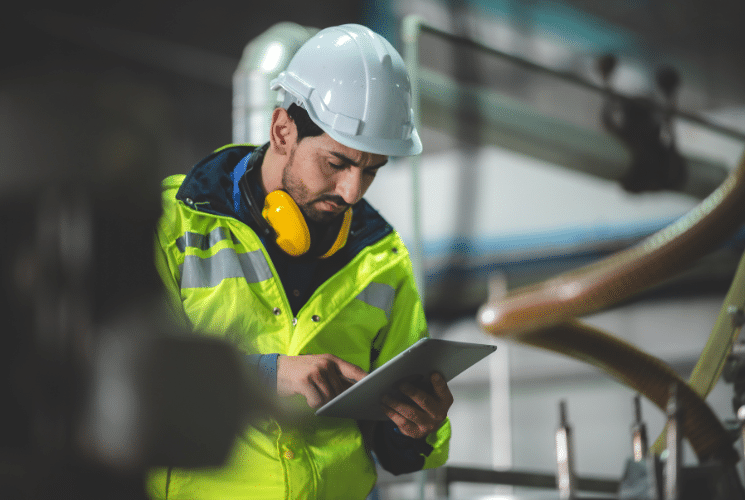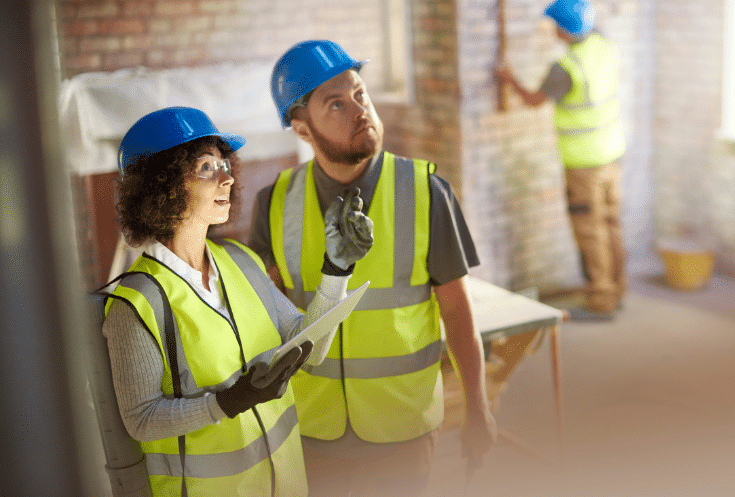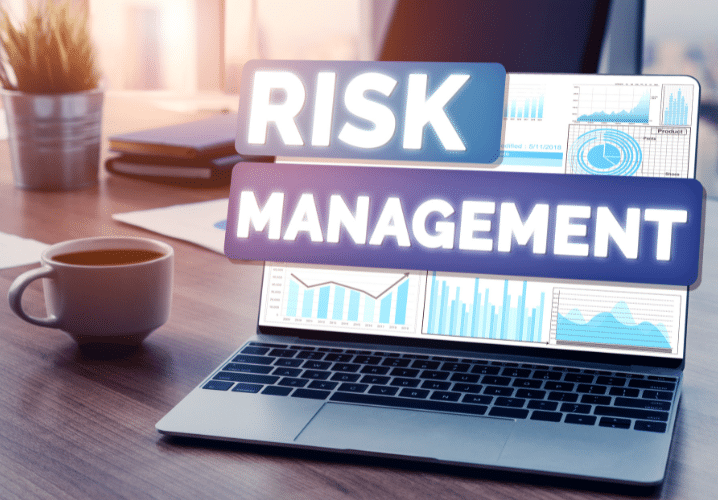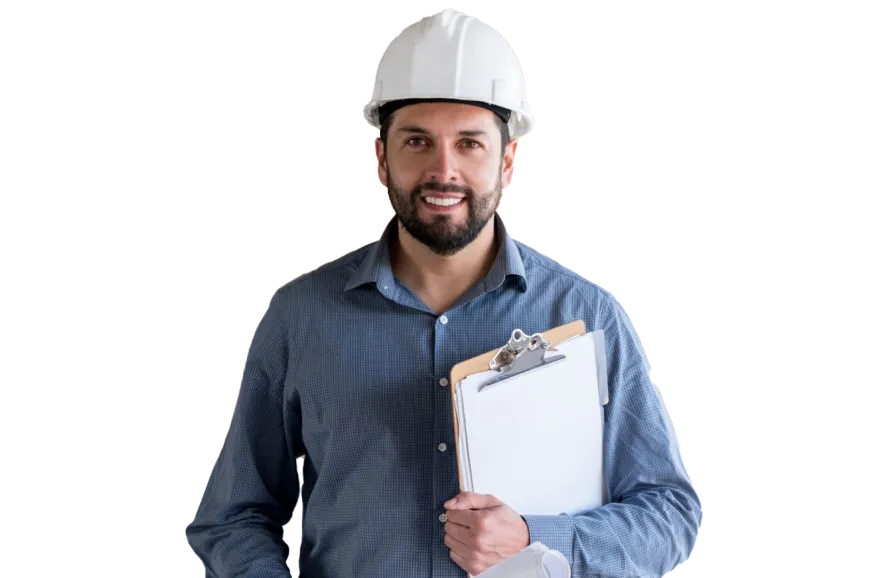May 16, 2024 10 min read
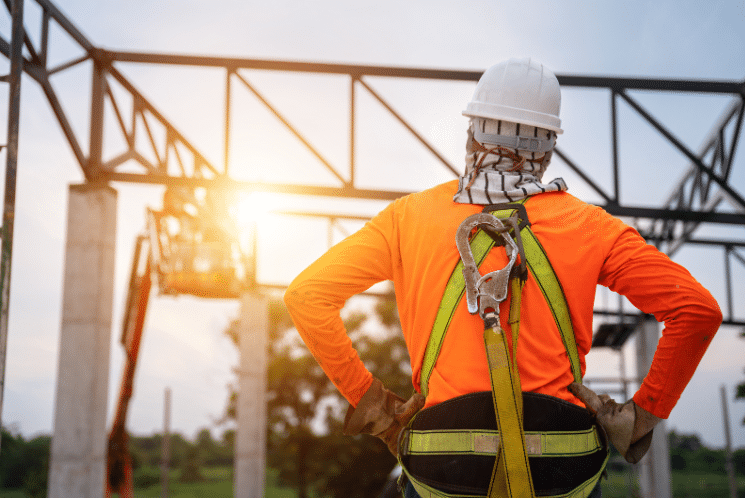
Complete Guide to Construction Fall Protection
Industry:
Solution:

Safety is top of mind on every construction site. And near the top of the list of safety concerns is fall safety. In this blog, we review everything you need to know about construction fall protection, exploring its significance, regulatory requirements, essential equipment, and actionable strategies for creating a robust fall prevention program.
What is Fall Protection in Construction?
Fall protection in construction is a set of safety measures and equipment designed to prevent workers from falling from elevated workspaces, such as roofs, scaffolds, ladders, and elevated platforms.
Construction work often involves tasks performed at heights, increasing the risk of falls for employees in this industry. In fact, falls are the leading cause of death in construction. 35% of all construction fatalities in 2020 were caused by a fall. Falls are also the most common OSHA violation.
Therefore, fall protection measures are essential for safeguarding the well-being of construction workers and mitigating the potential risks associated with working at elevated heights.
By understanding the principles of fall protection and implementing appropriate safety measures, construction companies can minimize the risk of falls and ensure the safety of their workers on the job site.
OSHA Reporting & Recordkeeping Guide
How to Comply with OSHA’s Requirements for Reporting and Recording Work-related Injuries and Illnesses
Download Guide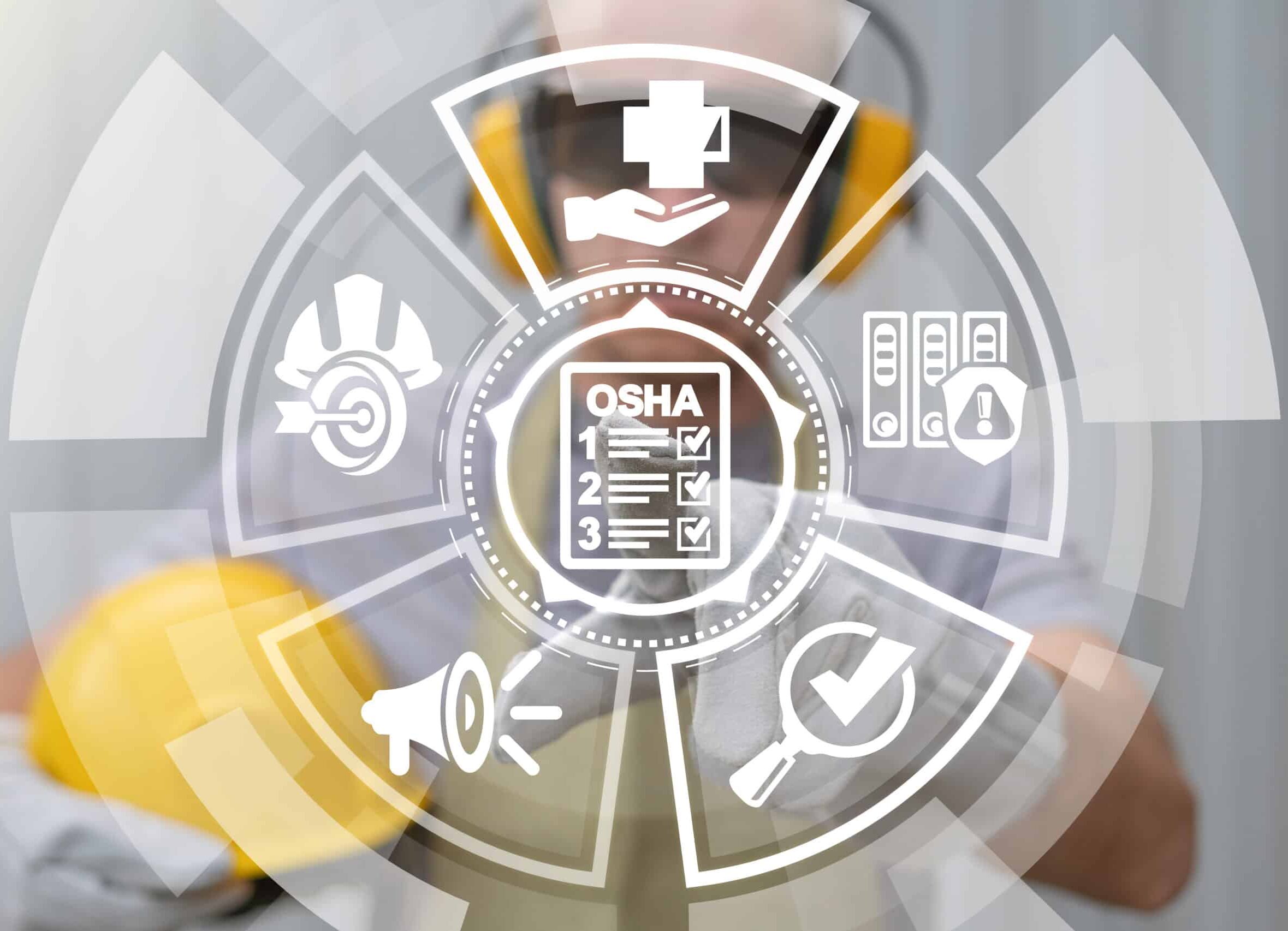
What is the construction fall protection height?
Fall protection must be required when employees are working at heights of six feet or more above the ground or a lower level. This is sometimes called the “6-foot rule” or the “fall protection rule.”
What are fall protection inspection requirements?
OSHA requires all personal protection systems to be inspected before initial use every shift. This inspection should cover looking for:
- Damage
- Deterioration
- Wear
- Mildew
- Any defective components
This inspection should also ensure that the personal fall protection equipment is compatible with all the connectors being used on the job site.
What is the OSHA Construction Standard for Fall Protection?
Under OSHA 1926.501, all construction firms have a duty to have fall protection for their workforce. This includes fall protection for:
- Walking and working surfaces
- Unprotected sides or edges
- Leading edges
- Hoist areas
- Holes
- Ramps, runways, and walkways
- Excavation sites
- Scaffolds
- Low-slope and steep roofs
- Wall openings
Employers are expected to provide various types of protection in these scenarios, including:
- Personal fall arrest systems
- Safety net systems
- Guardrail systems
- Covers
- Fences
- Barricades
NOTE: Please read the complete OSHA regulation for a comprehensive review of this standard.
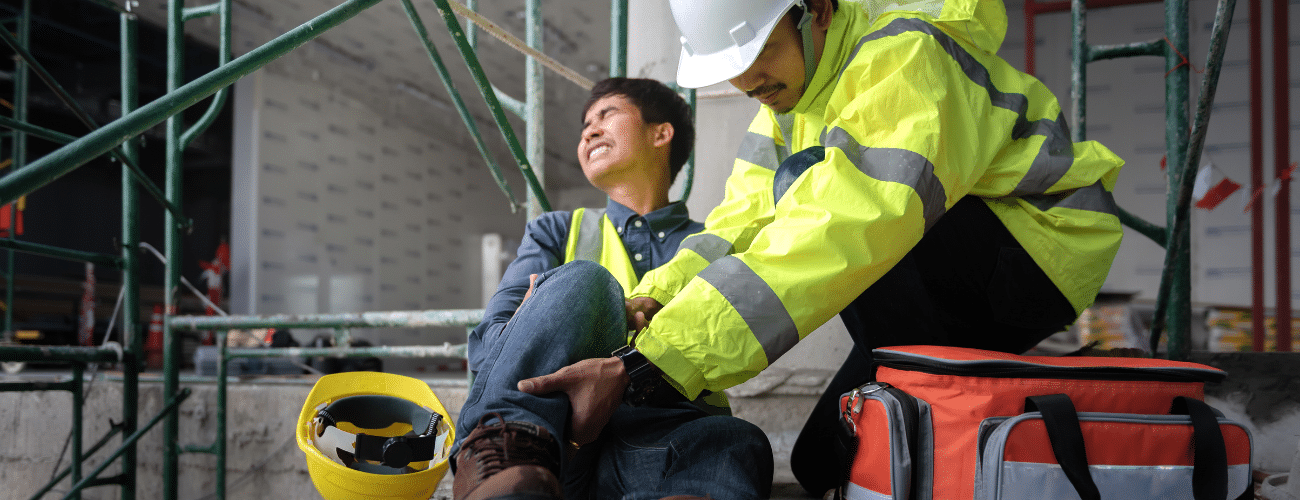
Why Construction Fall Protection Matters
Ensuring fall protection in construction is not just a matter of compliance; it’s about prioritizing the safety and well-being of workers. Construction sites pose significant risks of falls from heights due to elevated work areas, unprotected edges, and other hazards. By implementing effective fall protection measures, companies demonstrate their commitment to protecting their most valuable asset: the workforce.
Legal and Regulatory Compliance
Compliance with regulations set forth by organizations such as OSHA is non-negotiable. OSHA’s regulations mandate that employers provide fall protection systems and training to prevent falls from occurring. Failure to adhere to these standards can result in severe penalties and legal consequences for construction firms.
The Cost of Falls
The financial ramifications of falls extend beyond medical expenses and worker compensation claims. Construction companies may face additional costs related to project delays, legal fees, and reputational damage.
Preventing falls through comprehensive protection programs can greatly reduce these costs and preserve the organization’s financial health.
Reputation and Liability
Incidents involving falls can tarnish a construction company’s reputation and erode trust among stakeholders. Negative publicity resulting from accidents may deter clients from engaging with the firm, leading to lost business opportunities. Moreover, increased liability risks stemming from negligence in fall protection measures can expose companies to lawsuits and litigation, further damaging their standing in the industry.
Productivity and Downtime
Work interruptions caused by falls not only disrupt project timelines but also impede productivity on construction sites. When workers suffer injuries due to falls, project progress may be halted, leading to delays and cost overruns.
Implementing robust fall protection measures ensures continuity of operations and minimizes downtime, ultimately enhancing overall project efficiency.
Morale and Employee Retention
Prioritizing worker safety through effective fall protection initiatives fosters a positive work environment and boosts employee morale. Workers feel valued and supported when their safety is prioritized, leading to higher job satisfaction and retention rates. Conversely, neglecting fall protection measures can lead to disillusionment among employees and increase turnover, undermining organizational stability.

Construction Fall Protection Equipment
Construction fall protection equipment encompasses a range of devices and systems designed to prevent or mitigate the impact of falls from heights. Essential types of fall protection equipment include:
- Harnesses. Full-body harnesses distribute fall forces across the worker’s body and provide attachment points for lifelines or lanyards.
- Anchorage Points. Anchorage points are secure attachment locations for lifelines, lanyards, or anchor straps.
- Anchor Straps and Tie-Off Adapters. Anchor straps and tie-off adapters are used to create secure attachment points on structural elements or anchorages where permanent anchors are unavailable.
- Personal Fall Arrest Systems. These systems consist of an anchorage, connectors, and a full-body harness worn by the worker. In the event of a fall, the system arrests the fall and minimizes the impact on the worker’s body.
- Guardrail Systems. Guardrails are barriers erected along exposed edges, platforms, or openings to prevent workers from inadvertently stepping or falling off the edge.
- Safety Net Systems. Nets are installed below elevated work areas to catch falling workers and prevent them from hitting lower levels.
- Self-Retracting Lifelines (SRLs). These devices consist of a durable housing containing a length of lifeline or cable wound around an internal drum. As the worker moves away from the anchorage point, the lifeline extends, providing freedom of movement. In the event of a fall, an internal braking mechanism activates, locking the lifeline to arrest the fall.
- Safety Warning Lines. Warning lines are visual barriers erected around unprotected edges or hazardous areas to alert workers to potential fall hazards.
- Rescue and Retrieval Equipment. Rescue and retrieval devices facilitate the safe extraction of workers who have fallen or become suspended in fall arrest systems.
Construction Fall Protection Checklist
By following this checklist, safety managers can help ensure that effective fall protection measures are in place to protect workers from the risks associated with working at height in the construction industry.
Get a full copy of OSHA’s Job Specific Fall Protection Plan and Checklist.
Conduct a Risk Assessment
- Conduct a safety inspection to identify all potential fall hazards on the construction site:
- • Roofs or elevated surfaces 6+ feet above the ground or a lower level
- • Roofs or elevated surfaces 4+ feet above a hazard
- • Leading edges
- • Openings, holes, or skylights to a lower level
- • Stairways
- • Ladder use
- • Scaffolding use
- • Aerial lifts or scissor lifts
- • Hoist use
- • Other (fill in)
- Evaluate the severity of each hazard and the likelihood of falls occurring.
- Determine the appropriate fall protection measure for each hazard.
- Assign corrective actions to address fall hazards.
Provide Construction Fall Protection Training
- Use competency assessments to identify any gaps in employee knowledge about fall protection.
- Create learning plans to fill skills gaps and provide comprehensive training on fall hazards, fall protection systems, and safe work practices.
- Provide specialized training for workers involved in high-risk activities, such as working on scaffolds, elevated platforms, or roofs.
- Emphasize the importance of proper equipment usage, inspection, and maintenance using regular construction safety meetings.
Use Fall Protection Systems
- Implement appropriate fall protection systems based on the identified hazards, such as guardrails, safety nets, personal fall arrest systems (PFAS), or travel restraint systems.
- Ensure all fall protection systems are installed correctly and meet relevant safety standards and regulations.
- Regularly inspect and maintain fall protection equipment to ensure proper functioning and integrity.
Documentation and Recordkeeping
- Maintain detailed records of fall hazard assessments, training sessions, equipment inspections, and incident reports.
- Regularly review and update safety documentation to reflect changes in job site conditions, regulations, or best practices.
- Document all incidents and near misses to ensure OSHA compliance and spot trends safety lapses.
Vector EHS Management for Construction
Keep your employees safe with streamlined EHS management software. With Vector EHS, organizations can quickly respond to, investigate, and analyze workplace safety incidents and trends to prevent future or recurring issues.
Learn More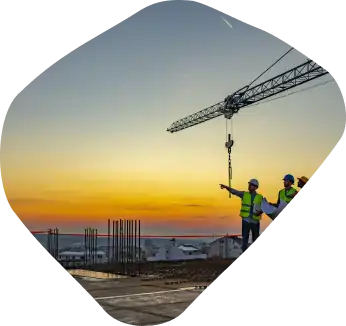
Creating Your Construction Fall Protection Program
Ready to get started? These are the key steps for creating a comprehensive construction fall protection program.
By following these steps, you can develop a robust Construction Fall Protection Program that effectively identifies and controls fall hazards, protects workers from injury, and ensures regulatory compliance on your construction site.
- Regularly assess fall risks using an EHS Management solution.
- Ensure regulatory compliance by familiarizing yourself with OSHA regulations and requirements.
- Empower site safety supervisors to use incident reporting data to identify larger safety trends and risks for the business and workforce.
- Create a written safety policy—which should encompass all safety measures, not just fall prevention. This policy should clearly define roles and responsibilities for personnel involved in fall protection, including management, supervisors, safety personnel, and workers. And it should include procedures for hazard identification, fall hazard control measures, fall protection equipment selection and use, training requirements, and incident reporting and investigation.
- Use fall prevention equipment and policies to prevent injuries. Ensure this equipment is regularly inspected and maintained.
- Provide comprehensive fall prevention training to all workers who may be exposed to fall hazards, including proper use of fall protection equipment, hazard recognition, and safe work practices.
- Keep detailed records of your fall protection program, including risk assessments, training records, equipment inspections, incident reports, and corrective actions.
- Conduct regular reviews and audits of your fall protection program to identify areas for improvement and ensure ongoing compliance with regulations and best practices.
- Foster a culture of safety within your organization by encouraging open communication, participation, and feedback from workers regarding fall prevention measures.
- Stay informed about advancements in fall protection technology, industry trends, and regulatory changes to continuously improve your fall protection program and enhance workplace safety.

Vector Solutions Construction Fall Protection Courses
Want to provide your workforce with industry-leading fall protection training? Vector Solutions offers numerous online training options to help keep your workforce informed about fall risks and safety measures.
Here are a few examples of the training we offer:
- Fall Prevention and Protection – Construction Worksite Safety: This comprehensive course reviews factors that can lead to falls, the dangers of falling, and numerous methods of prevention and protection.
- Stairs and Ladders in Construction – Construction Worksite Safety: Ladders and stairs are both sources of falls. This course reviews how to remain safe while using ladders and stairs.
- Slips, Trips, and Falls: This course describes common causes of slips, trips, and falls, how they can be prevented, and the proper first aid procedures to follow.
- Safety Management: Slip, Trip, and Fall Prevention Inspections: A comprehensive floor and walkway safety program can reduce slips, trips, and falls. This course reviews how to create these safety programs and how to conduct routine inspections and change analyses.
- Slips, Trips, and Falls High Risk Areas: This microlearning course reviews the highest risk areas for slips, trips, and falls.
Want to learn more about how Vector Solutions can help you with fall prevention? Request a demo today to see our construction training and safety management solutions in action.




